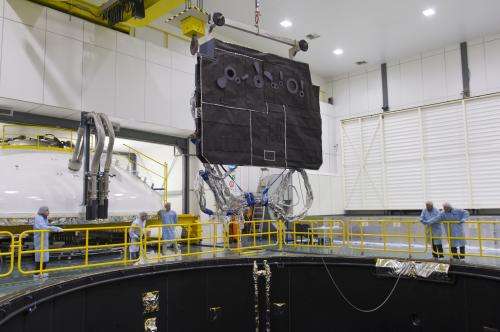Image: The sunshield for ESA's Solar Orbiter

(Phys.org) —Members of ESA's Solar Orbiter team watch expectantly as an essential part of the spacecraft is lowered into Europe's largest vacuum chamber: the multi-layered shield that will protect their probe from the Sun's remorseless glare.
This engineering model of the sunshield, sandwiched together from multiple layers of titanium and outermost carbon coating, was placed in the 15 m-high and 10 m-diameter Large Space Simulator at ESA's Technical Centre, ESTEC, in Noordwijk, the Netherlands, on 2 May.
Solar Orbiter, due for launch in 2017, will carry a portfolio of instruments for high-resolution imaging of our parent star from as close as 42 million km – a little more than a quarter of the distance to Earth.
Operating in direct view of the Sun, the mission must endure 13 times the intensity of terrestrial sunlight and temperatures rising as high as 520°C.
The main body of the spacecraft will therefore be huddled behind a multi-layered 3.1 m by 2.4 m sunshield, with the circular holes for cameras to peep through, many behind protective glass or beryllium.
The question is, can the sunshield keep up the insulating performance the Solar Orbiter mission and its sensitive instruments demand?
As its crucial test begins, all air will be extracted to produce space-quality vacuum, while the chamber walls are pumped with –190°C liquid nitrogen to mimic the extreme cold of deep space.
Then the light from 19 xenon lamps, each consuming 25 kW, will be tightly focused by mirrors into a concentrated beam of artificial sunlight upon the sunshield for a number of days.
The roof of the Simulator can be seen in the left-hand background of the image, ready to slide into place to seal the chamber for testing.
Provided by European Space Agency



















